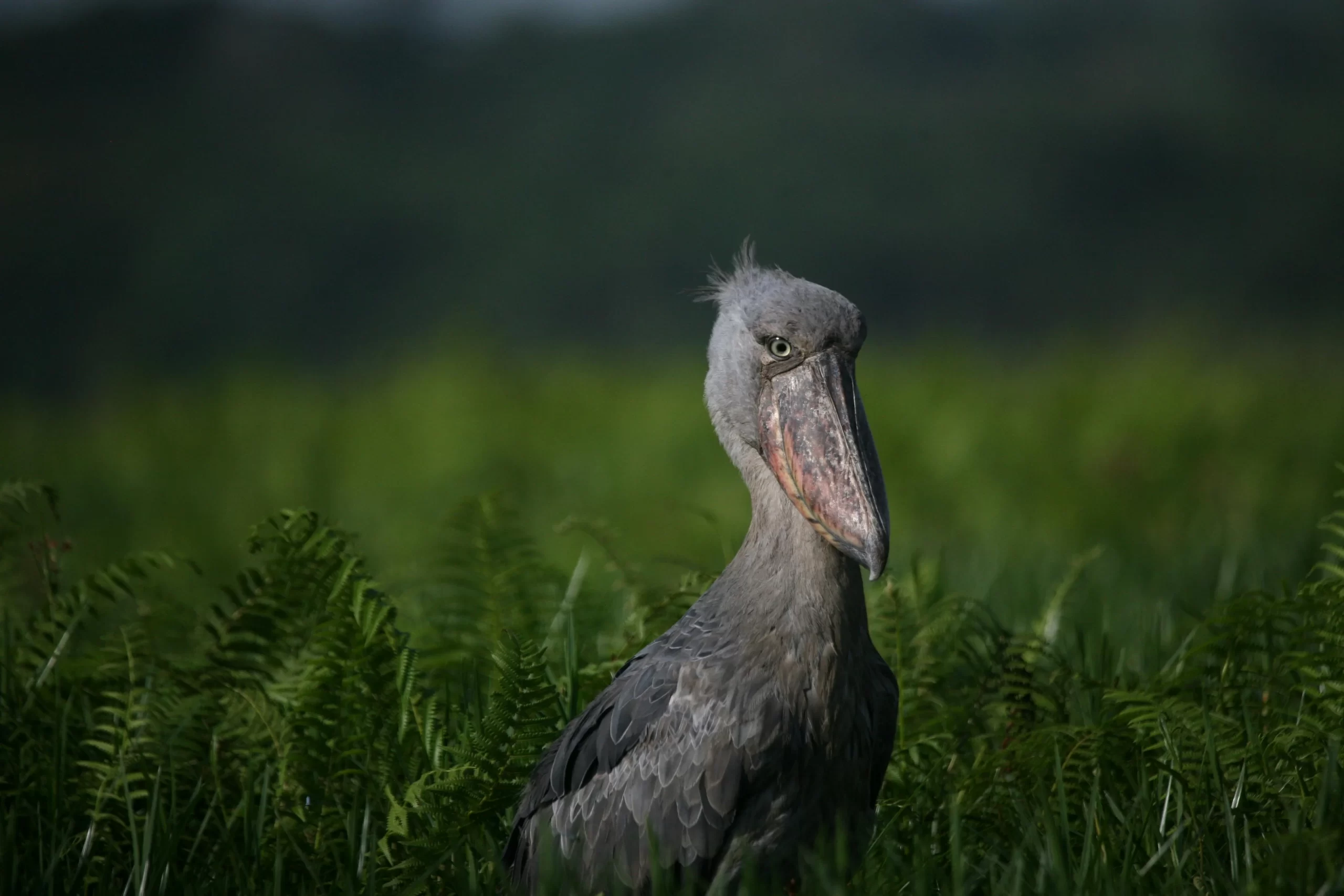Uganda is a nation that is rich in bird diversity, as 1,000 species have been observed in this small East African country. Despite its petite size, Uganda packs an impressive array of habitats within its borders. Indeed, the southern half of the country is nestled along the equator and home to some impressive tracts of forest. Meanwhile, large lakes such as Lake Victoria, Lake Kyoga, and Lake Albert can be accessed in Uganda. Of course, there are also many wetlands and grasslands in this nation, and–unsurprisingly–the birds of Uganda are exceptional.
Those interested in learning about the types of birds in Uganda and their names have come to the right place. I’ve created this photo guide to introduce you to some of the common birds in Uganda. Additionally, I’ll share some of the most incredible birds that can be seen in Uganda. If you’re a birder who is considering visiting this remarkable East African nation, then you won’t want to miss out. Let’s learn about the birds of Uganda!
Table of Contents
10 Common Birds In Uganda
Although there are plenty of bucket list birds to find in Uganda, those visiting should also be familiar with some of the common birds in Uganda that they should expect to observe. Therefore, the following section will include the 10 most common birds of Uganda as per eBird data.
Common Bulbul
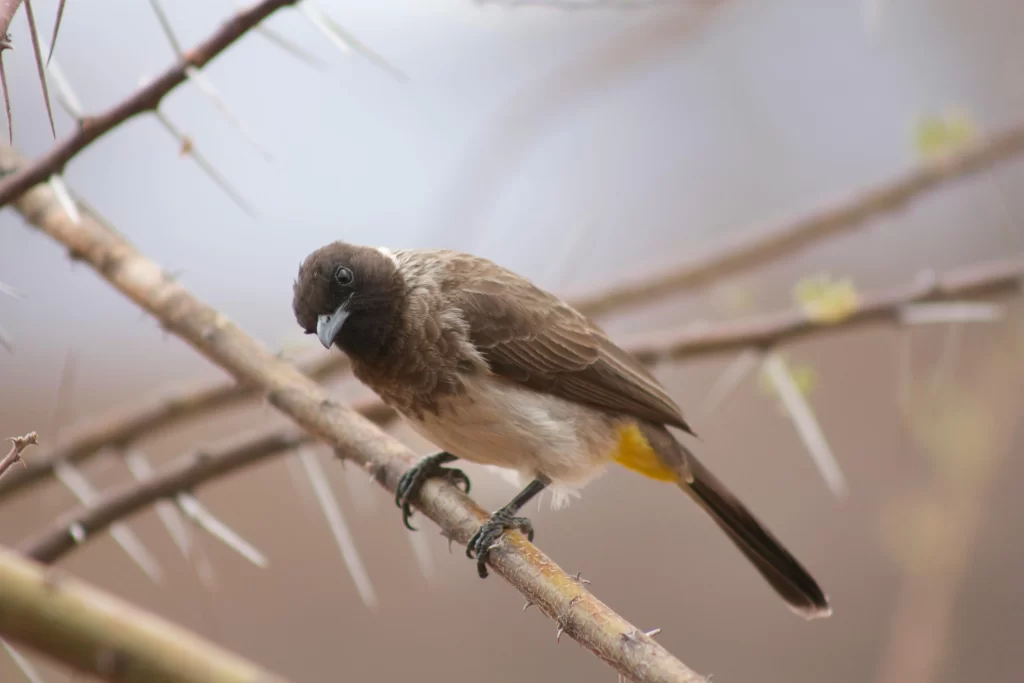
Common Bulbuls are quite variable in the differences in plumage that they display across the African continent. Those in Uganda belong to the dark-capped, tricolor subspecies. This bird of Uganda has yellow vents, white stomachs, brown bodies, and dark heads.
Being habitat generalists, Common Bulbuls can thrive in areas where other birds wouldn’t find success. These wild birds of Uganda love to eat fruit, therefore, they can excel in any area with enough fruiting trees and shrubs for them. Even arid locations with minimal trees can support this Uganda bird if sufficient food is present.
More than 17,000 Common Bulbuls have been observed in Uganda, meaning they’ve been observed on about 37.50% of all birding outings in the country. Listening for the song of a few ascending notes followed by a descending note can help birders find these birds in Africa.
Speckled Mousebird
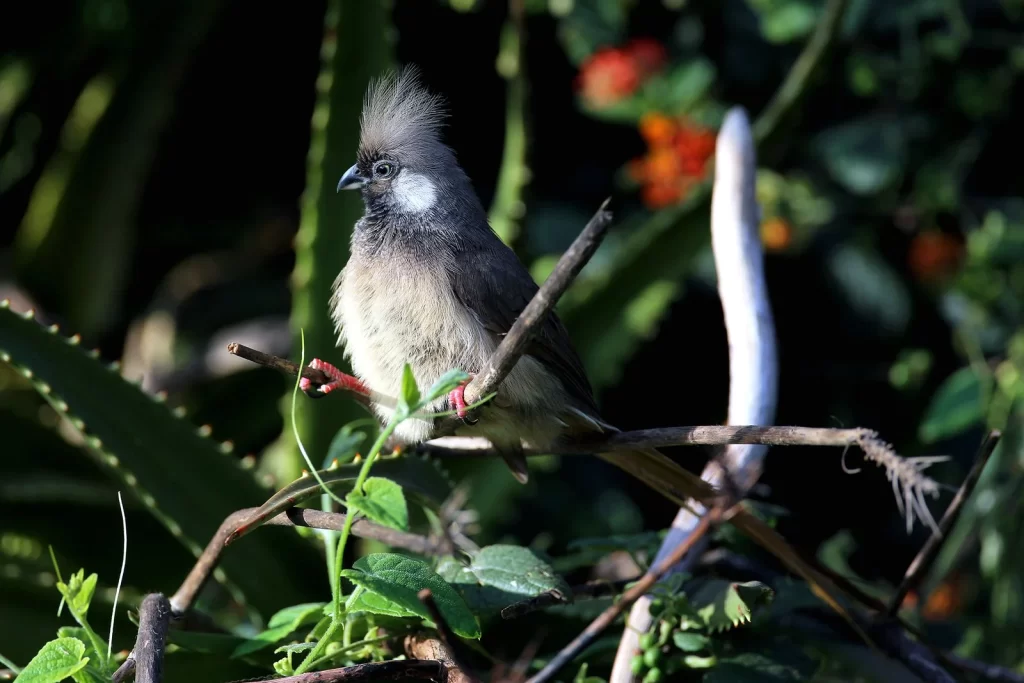
Speckled Mousebirds stand out with their exceptionally long tails and puffy crests. Indeed, it’s easy to see why these birds of Uganda aren’t often overlooked. Sexes are monomorphic, with each having tawny undersides and drab brown-gray backs. The bluish eyes of these creatures are memorable.
Speckled Mousebirds have flourished because their habitats of choice feature young trees and shrubs in semi-open areas. Therefore, they are a species that has benefited from deforestation in Uganda. These birds of Uganda are among the most familiar birds within Ugandan towns.
Speckled Mousebirds become very familiar with their territories throughout their lives, as they rarely leave such places. Indeed, these Uganda birds do not engage in any migration, and they rarely stray from their territories. These beautiful birds in Uganda are observed on 24.3% of eBird checklists.
Hadada Ibis
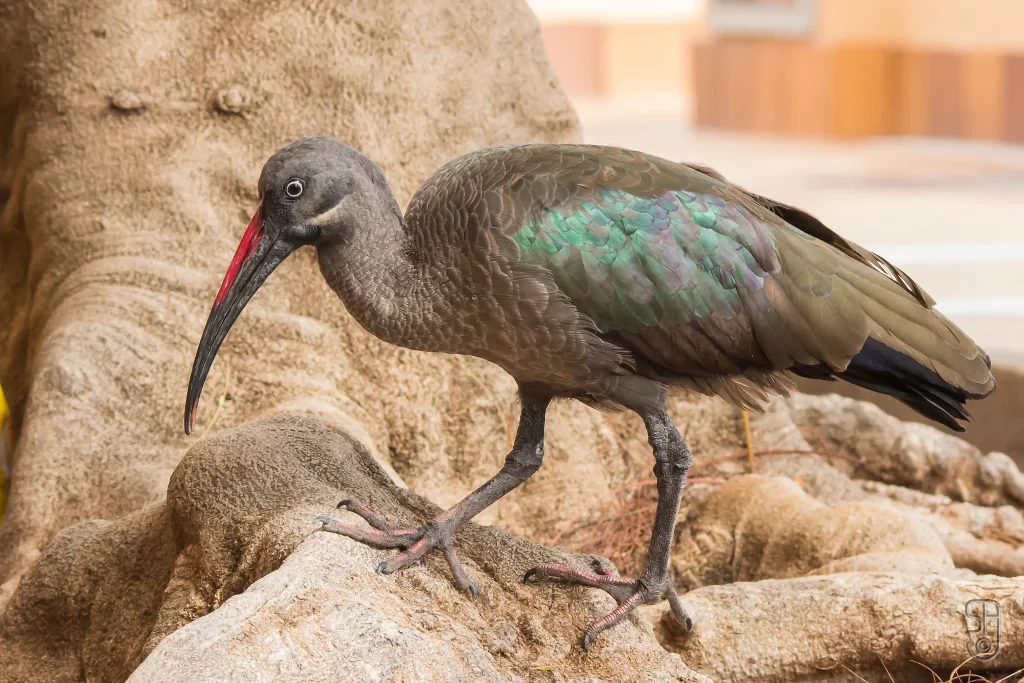
Hadada Ibises are the most common of the three ibis species that regularly occur in Uganda. They are grayish overall with stunning green iridescent wings and a white stripe that trails the bottom portion of their faces.
Although Hadada Ibises may forage in aquatic habitats like wetlands, lakeshores, and rivers, they are more commonly found in open savanna and forest edges. Birders may be keyed into their presence by their calls, which some liken to the maniacal laughter of imaginary witches.
Hadada Ibises are common Uganda birds, but they are certainly not as numerous as many of the other birds on this list. Nonetheless, being big birds in Uganda, their large size makes them readily visible. This has led to Hadada Ibises being observed on 23.80% of eBird checklists.
Green-backed Camaroptera
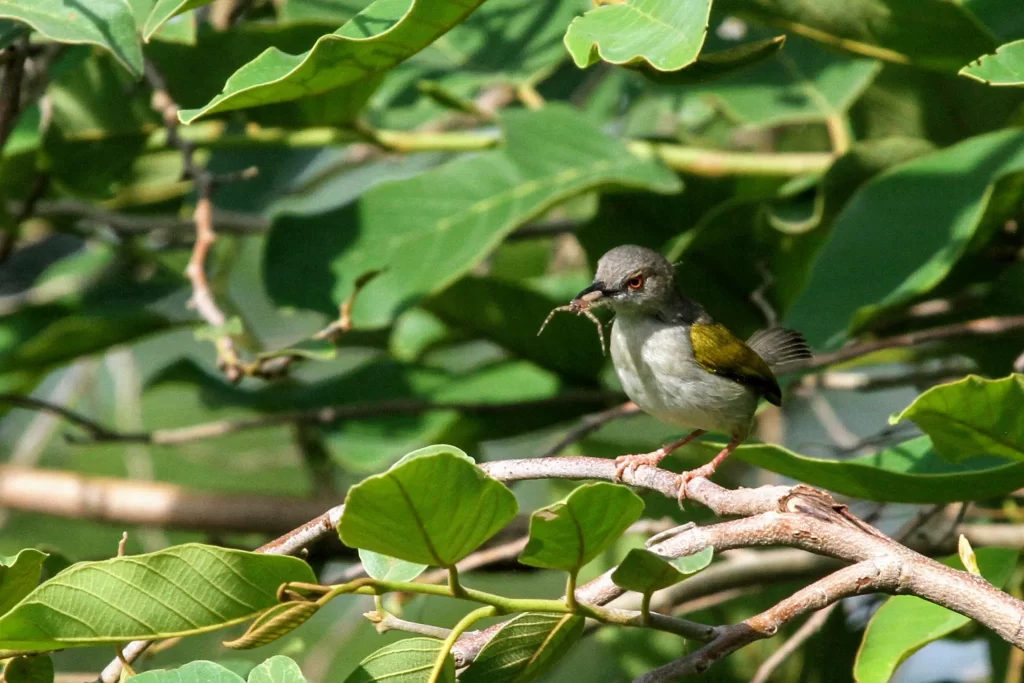
Image attribution: “Green-backed Camaroptera” by Greg Schechter is licensed under CC BY 2.0
Green-backed Camaropteras are on the opposite end of the size spectrum as Hadada Ibises, being small birds in Uganda. The grey-backed subspecies is found in Uganda, and although they lack green backs, they’ve got vibrant green wings.
Green-backed Camaropteras thrive in the understories of forests, but this bird of Uganda can make do with small woodland tracts in the absence of extensive forests. They are abundant on the western border of Uganda, but they can be found throughout the entire country.
These tiny birds of Uganda are happy to remain in their territory for their whole lives, as they rarely move further than a few km in Uganda. Green-backed Camaropteras are observed on about 22.6% of eBird checklists in Uganda. Birders can readily detect these Ugandan birds thanks to their distinctive song that sounds like someone flicking an outstretched rubber band.
Red-eyed Dove
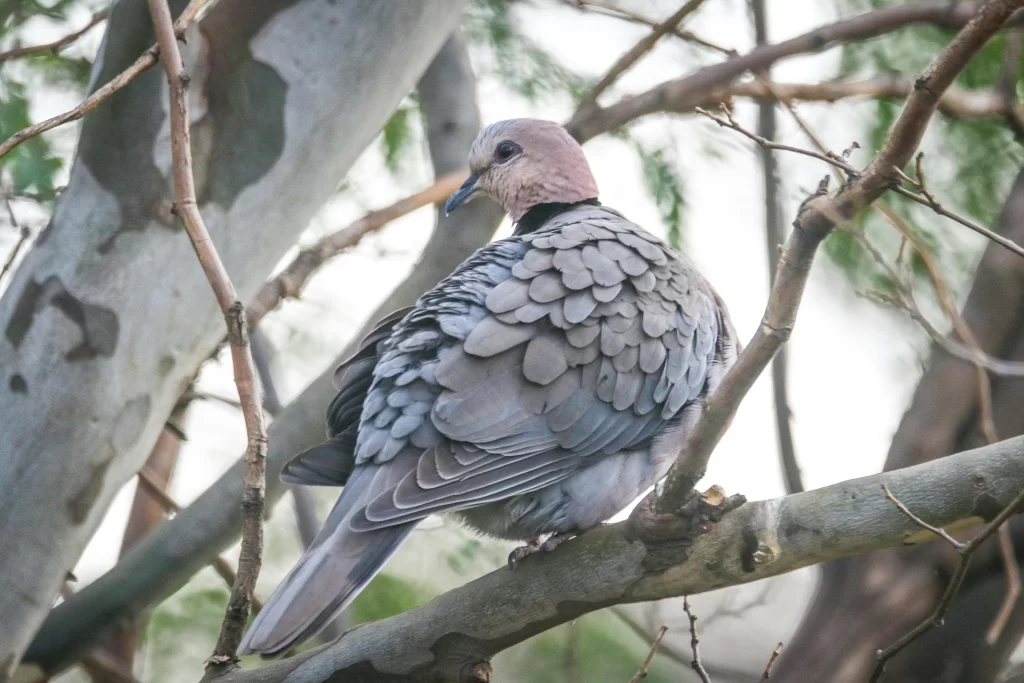
Red-eyed Doves are chunky doves with short tails. These Uganda birds do–indeed–have red eyes. Moreover, they’ve got pale gray bodies and black-half collars around their necks.
These birds of Uganda are not too choosy in their habitat requirements, as any wooded area adjacent to water will do. Therefore, forests, woodlots, parks, and towns can all host Red-eyed Doves. They eat a diet similar to that of all pigeons and doves, as seeds, berries, and insects make up the bulk of these dove’s diets. They primarily forage on the ground.
A Red-eyed Dove’s song is 6 syllables long, with a pause between the second and third syllables. It is a familiar sound across the sub-Saharan African landscape, and it has been likened to, “I-AM-a-Red-eyed-Dove”. Red-eyed Doves are observed on 22.38% of Ugandan checklists.
Rüppell’s Starling
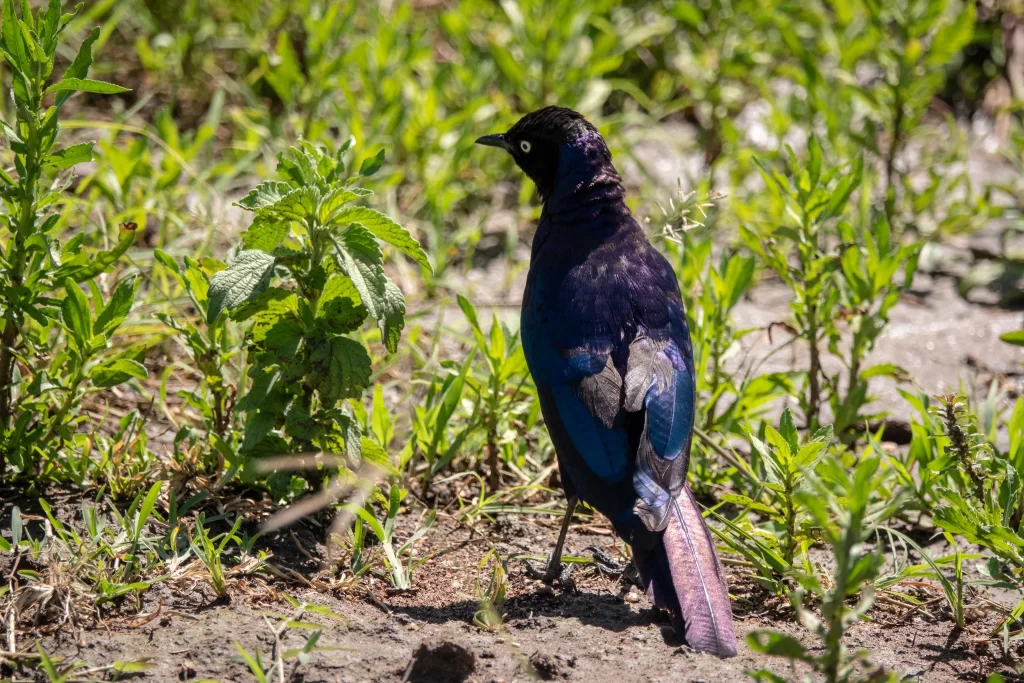
Rüppell’s Starlings look much like a combination of a starling and grackle. However, despite their appearance, they are all starling. These iridescent black and blue birds in Uganda have long tails and small heads in proportion to their bodies.
Uganda is a stronghold for this species, as the entire nation is located within its range. Rüppell’s Starlings seek semi-open areas with scattered trees. Agricultural land, grasslands, and urban areas are all appealing locations for them, but they must have some form of water nearby.
Rüppell’s Starlings are social birds, being found in groups containing several birds. They’ve got well-rounded diets, eating berries, insects, and even scraps left behind by people. These Uganda birds observed on 21.65% of eBird checklists.
Black Kite
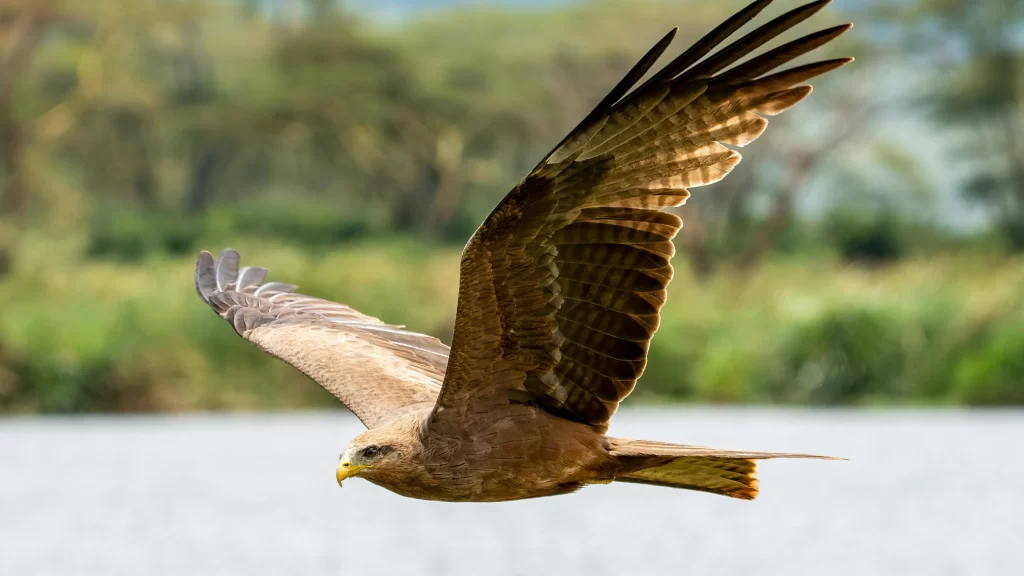
Black Kites are the most common raptors in Uganda, with these birds of prey being present here in the largest numbers during winter. During this season, birds that breed in Europe congregate in places such as Uganda. Although many Black Kites leave Uganda come summer, there are still plenty that breed here.
The Black Kites found in Uganda are scarcely black at all, as their bodies are primarily brown with black wingtips. Black Kites are adaptable, being found in a wide array of habitats. It seems that the only habitats that they avoid are dense forests and bustling urban areas, therefore, look for them in wetlands, grasslands, and agricultural areas.
Black Kites are found on 18.70% of Ugandan checklists. These big birds in Uganda eat lots of different meals including carrion, scraps, and live prey. They’re commonly found near humans, making some worry about attacks from Black Kites. Fortunately, Black Kites are completely harmless to people.
Western Cattle Egret
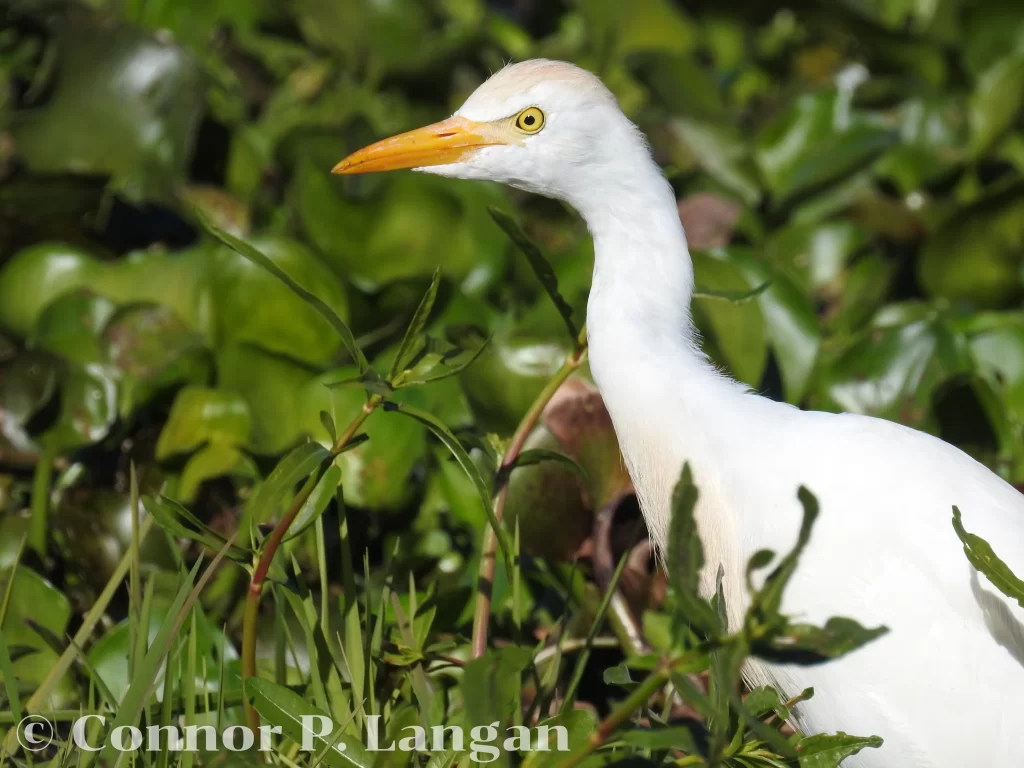
Western Cattle Egrets are abundant throughout much of Uganda. Yes, these small egrets are rather nondescript, being white with toasted marshmallow brown in the breeding season. Western Cattle Egrets are social birds, roosting and breeding with other herons and egrets.
They thrive in wetland habitats, but they also do well in short grasslands and other open areas. Here, these Ugandan birds readily trail after cattle or large mammals in the hopes of finding insects.
Western Cattle Egrets are prime examples of wild birds in Uganda that have extensive diets. In addition to insects, they’ll eat amphibians, reptiles, small mammals, and birds. They’re observed on 17.84% of all Ugandan checklists, and they’re one of the most familiar birds in the country.
Northern Gray-headed Sparrow
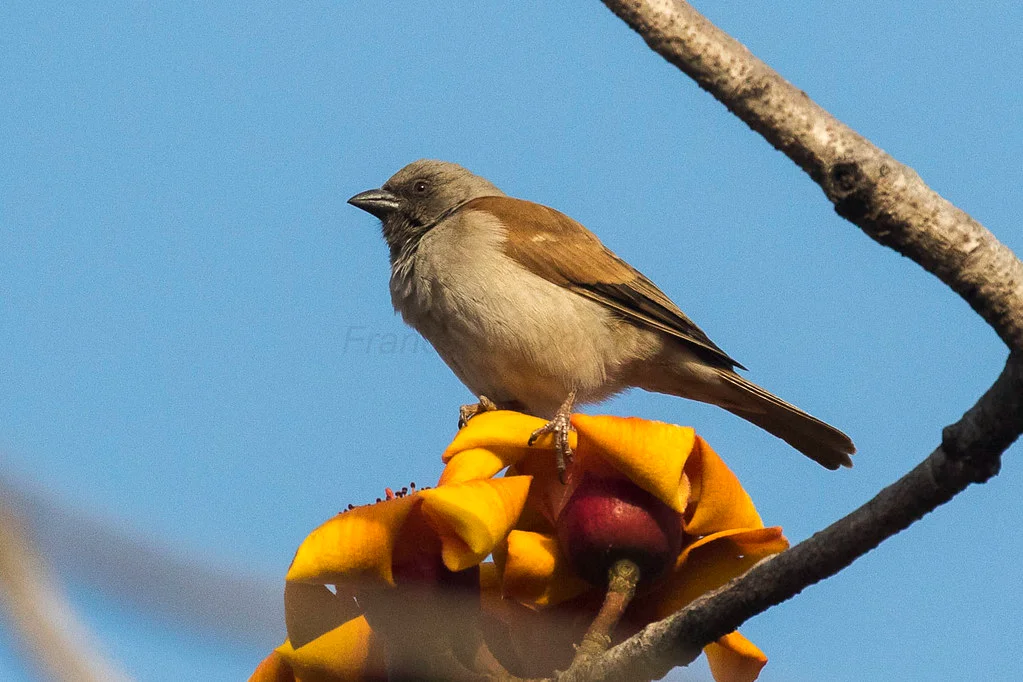
Image attribution: “Northern Grey-headed Sparrow – Gambia 17_CD5A1959” by Francesco Veronesi is licensed under CC BY-SA 2.0
Northern Gray-headed Sparrows are an aptly named small Uganda bird. Indeed, both sexes have gray heads and brownish bodies. These creatures have the same shape and build as the closely related House Sparrow – a species that has been introduced to Uganda.
Fortunately, Northern Gray-headed Sparrows are native to this country. These birds of Uganda thrive in open and semi-open areas throughout the country. This means that agricultural areas, grasslands, and open woodlands are great places to check for this bird of Uganda.
About 17.66% of eBird checklists from Uganda contain Northern Gray-headed Sparrows. These social birds are typically found in pairs during the breeding season, however, they branch out and reorganize themselves into bigger groups in the nonbreeding season.
African Palm Swift
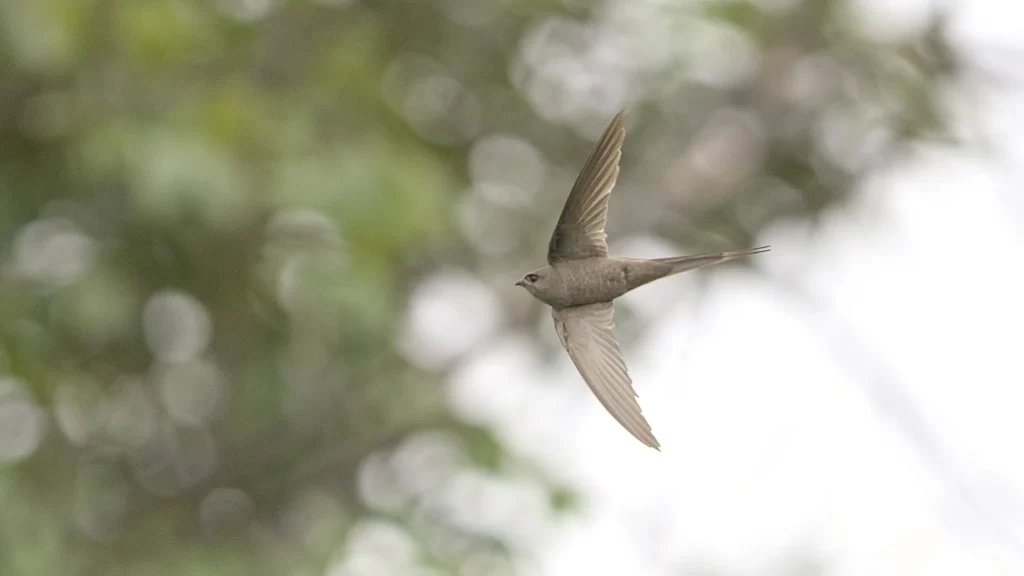
Image attribution: “African palm swifts (Cypsiurus parvus) showing them around their palm )(Hyphaene petersiana) habitat.” by Derek Keats is licensed under CC BY 2.0
Although common, it’s difficult to get a good look at an African Palm Swift because of the rapid flight and aerial lifestyles of these Uganda birds. Indeed, most will just notice a brown blur darting through the skies. However, for those lucky enough to get a good look, you will notice that their long wings and tail are well-adapted for life in the skies.
African Palm Swift nest in–you guessed it–palm trees. Both males and females gather nesting materials in midair and work to jointly construct their saliva-bond nests. These Ugandan birds seek out areas adjacent to water, and they’re generally absent from locations that lack such a resource.
African Palm Swifts are observed on 17.63% of Ugandan checklists. They provide great services to humans as they dine on a variety of insects in midair. These types of birds in Uganda readily fly with other African Palm Swifts, sometimes forming tight formations as they zip through the sky.
6 Incredible Wild Birds in Uganda
Most birders don’t venture to Uganda to observe the common birds that this country has to offer. Instead, they’ll surely be looking for some of the 6 incredible birds that I’ve included on the following list.
Shoebill
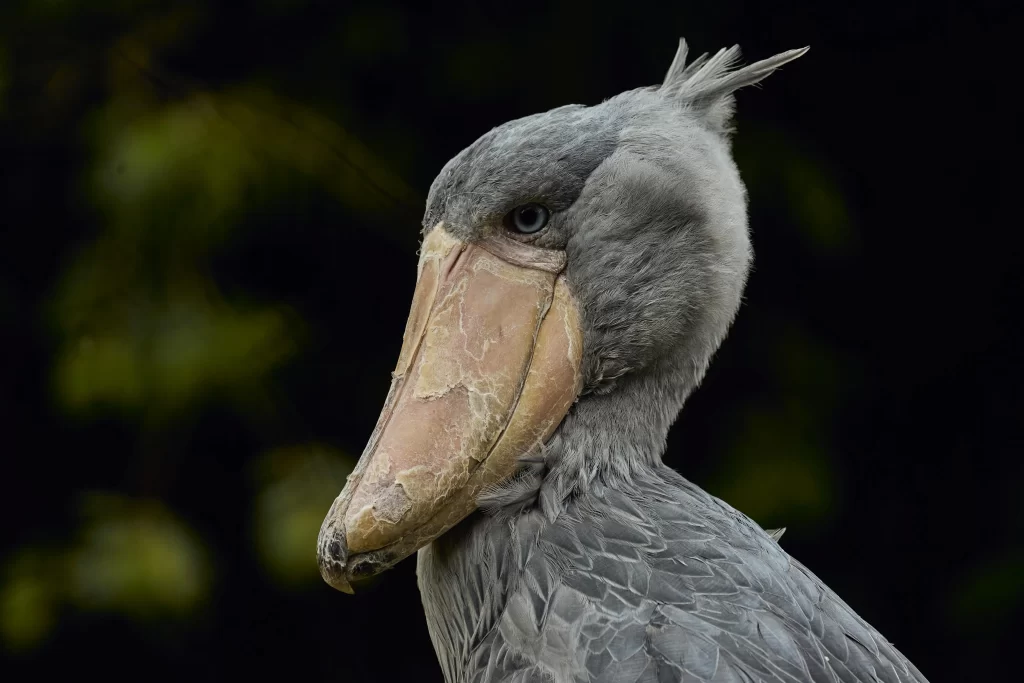
A list of birds in Uganda wouldn’t be complete without the inclusion of the Shoebill. Indeed, they are massive, remarkable big birds in Uganda. It’s hard to misidentify a Shoebill if one gets a good look at this species. Indeed, they’re huge blue-gray birds with enormous bills.
Although one would think that finding a Shoebill would be simple given its size, this is a common misconception. Shoebills frequent dense wetlands that feature vegetation tall enough to obscure them. Moreover, these blue birds of Uganda are wary and they won’t hesitate to take flight if they feel threatened.
There have been nearly 1,500 observations of Shoebills in Uganda, so they can readily be found by those who make the effort to search for them. Uganda is among the best locations in the world to view these vulnerable bird species. Unfortunately, there may be fewer than 10,000 Shoebills that remain
Lesser Flamingo
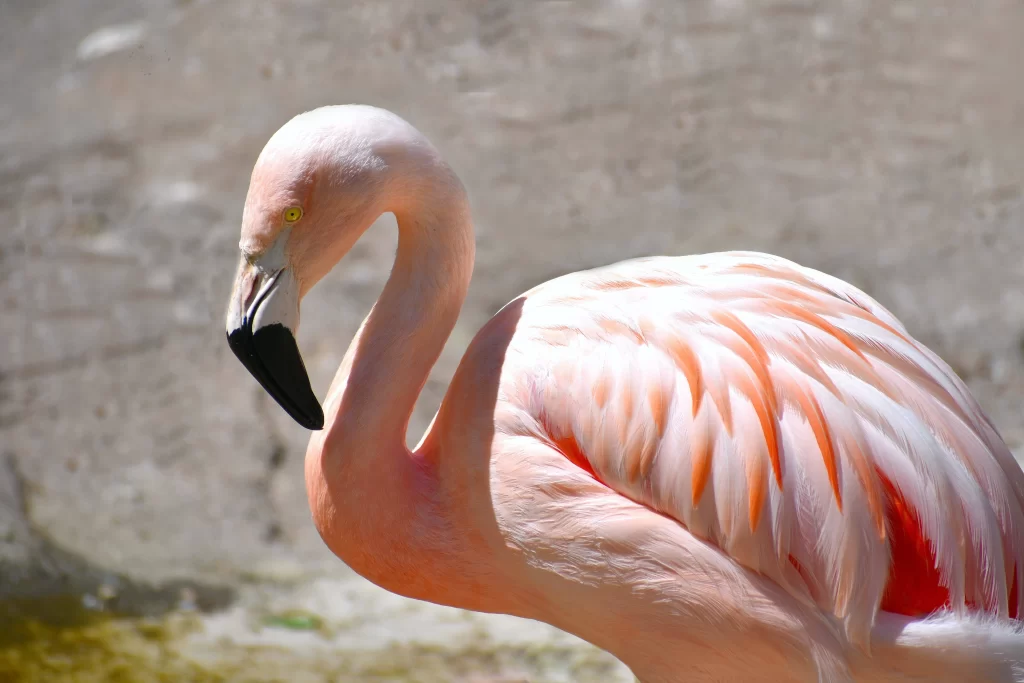
Lesser Flamingos are one of two flamingos in Uganda, being more common than the similar Greater Flamingo. Lesser Flamingos are pale pinkish overall with bright pink legs and dark bills. They’ve got extensive black on the wings in flight, but this color can’t be seen on foraging birds.
Like other flamingos, Lesser Flamingos frequent salt flats and similar saline habitats. Here, they readily feast on invertebrates and algae that specifically grow in these ecosystems. Having such specific habitat requirements means that Lesser Flamingos are only found in specific locations in Uganda. Indeed, it seems that Queen Elizabeth National Park is the only reliable place to find them in Uganda.
Like several other flamingo species, Lesser Flamingos populations are threatened. Although their population is still in excess of one million birds, numbers have declined substantially in the past few decades. There have been more than 400 observations of these rare birds of Uganda.
Gray-crowned Cranes
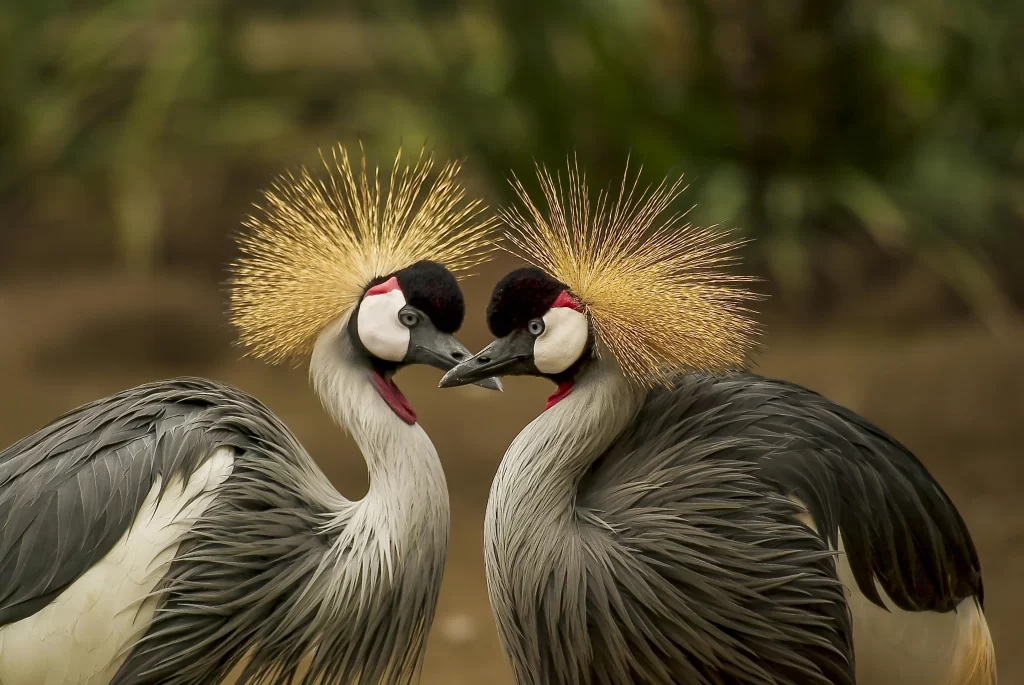
The Gray-crowned Crane is Uganda’s national bird, so it deserves a place on this list of birds in Uganda. These big Uganda birds are distinct with their gray and white bodies and–of course–their trademark yellow crowns.
Wetlands, grasslands, rangeland, and agricultural areas are optimal locations for these birds with mohawks. They are one of the few species of crane that can perch in trees or wooden posts, so don’t be shocked if you witness them exhibiting such behavior.
Despite their significance in Ugandan culture, Gray-crowned Cranes are an endangered species. Although they still have a population that is a respectable size, their numbers have declined dramatically in the past half-century. It is thought that intense human modifications to the landscape are to blame for this decline. Nonetheless, there have still been nearly 4,000 observations of Gray-crowned Cranes in Uganda.
Marabou Stork
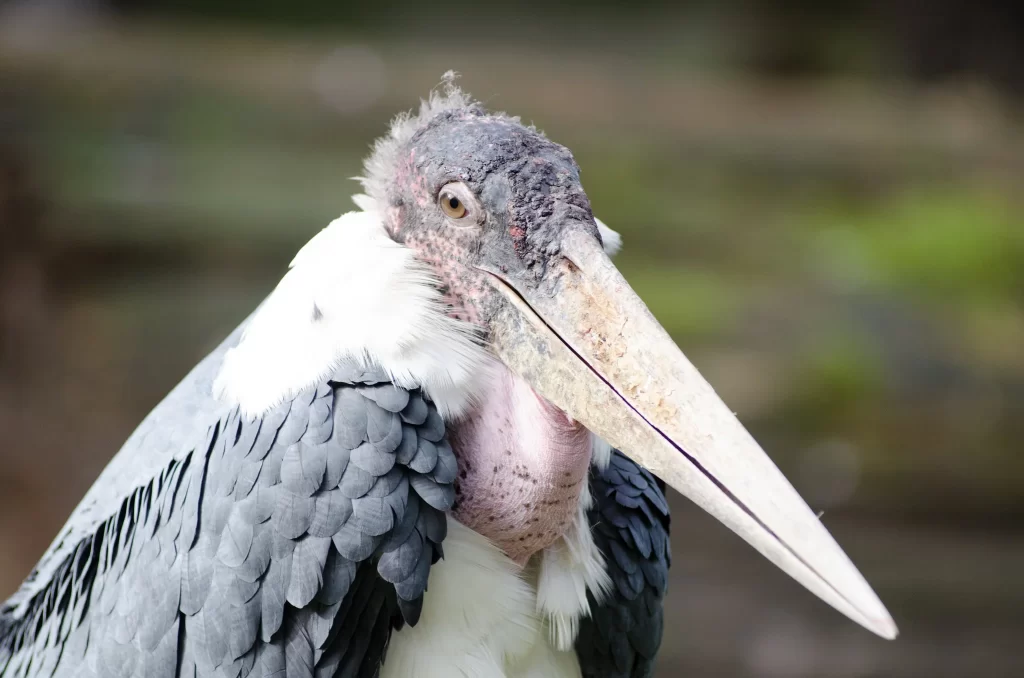
Marabou Storks are enormous storks that take the cake for the biggest Ugandan bird on this list, even edging out the similarly massive Shoebill. This Uganda bird has a clean white underside and dark back. Their heads are mostly bald, and their bills are long, thick, and imposing.
Marabou Storks thrive in open and semi-open areas such as grasslands, wetlands, and open woodlands. Moreover, these birds of Uganda can become quite accustomed to living near humans, leading them to frequent garbage dumps, fishing villages, and other areas where they can find easy meals. Marabou Stork parents don’t kill their babies like some other storks, but chicks may commit siblicide.
Marabou Storks are doing well in Uganda. Here, their populations have soared, and there have been more than 6,000 observations. These birds of Uganda consume fish, carrion, and a variety of animals. They are often found near the kills of large predators as they try to find an easy meal.
Martial Eagle
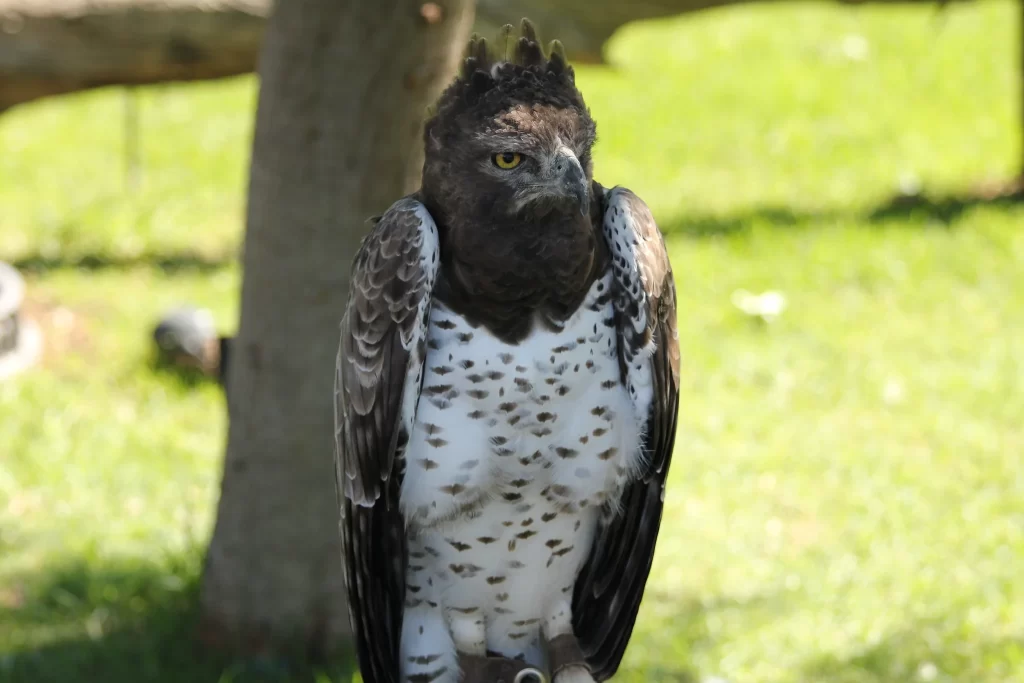
Image attribution: “Martial Eagle” by Jon Mountjoy is licensed under CC BY 2.0
Martial Eagles are dark brown above with white speckled undersides when in mature plumage. Moreover, they’ve got dazzling orange eyes. Although there are many hawks and eagles in Uganda, Martial Eagles are bigger than most and are generally easy to identify.
The edges of forests and other semi-open habitats are great spots to look for Martial Eagles. Such locations provide ample perches for hunting, but they’re still open enough and allow for enough room to maneuver. Martial Eagles avoid thick forests and urban areas.
Although populations of Martial Eagles in Uganda are still stable, this species is a globally endangered bird. Yes, the population of these Ugandan birds of prey has declined globally in the past few decades largely due to persecution, as people intentionally poison them or shoot them because they occasionally eat domestic birds in Uganda.
Abyssinian Ground-Hornbill
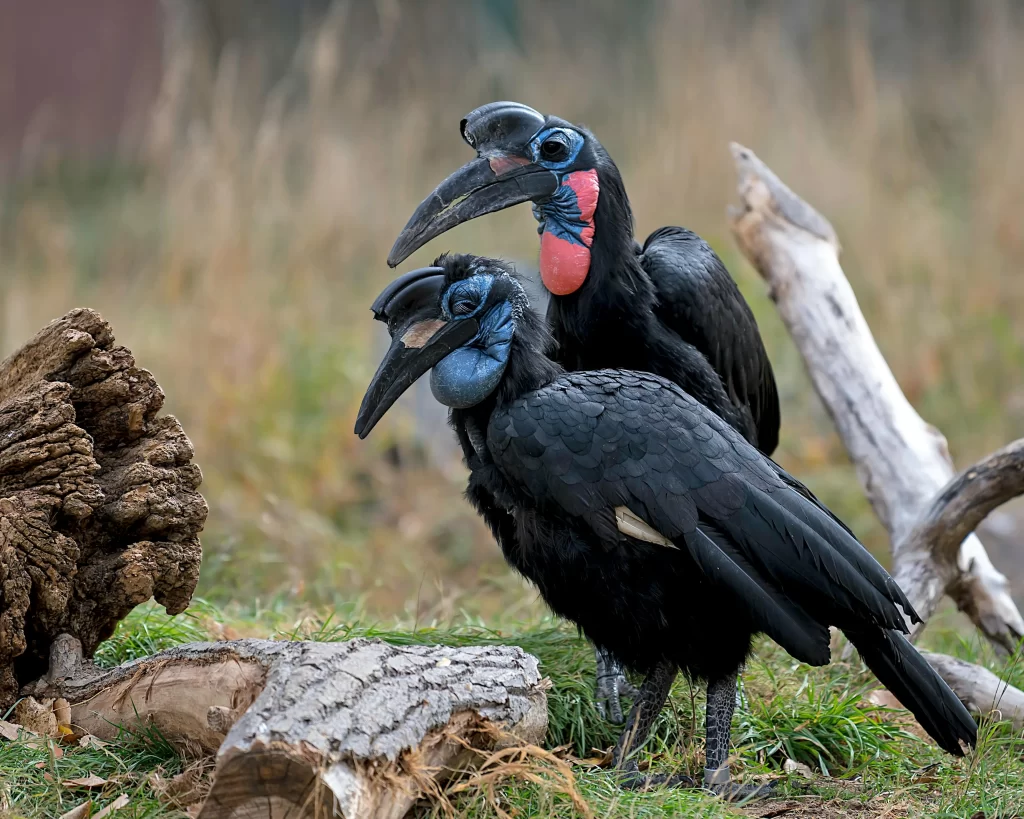
Abyssinian Ground-Hornbills are a stunning bird to observe, as their substantial size and ornate colors are certainly eye-catching. They are moderately sexually dimorphic, but males and females look the same save for the red throat skin of males. Both sexes have a black casque atop their bills.
These birds of Uganda inhabit dry grasslands with scattered trees. They are locally found in Uganda, as many areas of the nation are unsuitable for Abyssinian Ground-Hornbills. Places such as Semuliki Wildlife Reserve, Murchison Falls National Park, and Kidepo Valley National Park are excellent places to observe them.
There have been about 1,800 observations of Abyssinian Ground-Hornbills in Uganda. Though populations are seemingly stable in Uganda, these birds are considered to be vulnerable globally. Much more research can be done on these scavenger birds, but ornithologists know that they may live for more than 40 years.

